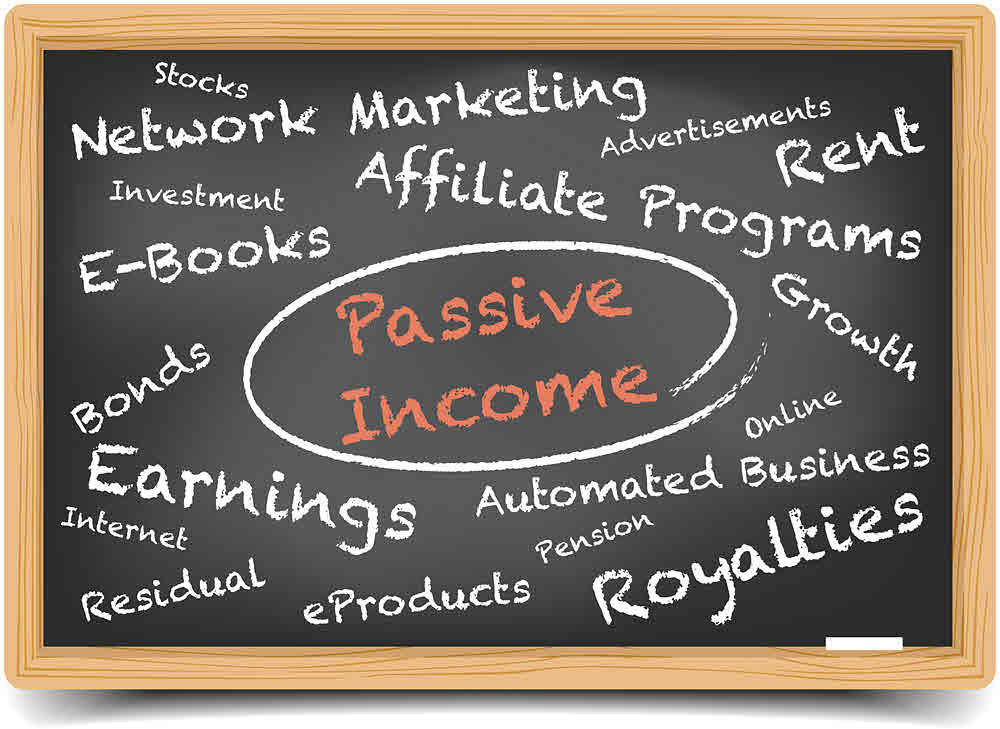If you dream of achieving financial freedom and creating a steady income stream that doesn't require constant active effort, passive income streams are the perfect solution. Passive income refers to money earned on an ongoing basis with minimal effort and time investment. It allows you to generate revenue while enjoying the flexibility to pursue other passions, spend time with loved ones, or explore new opportunities.
Throughout this post, we'll explore the concept of passive income streams and highlight their numerous benefits. Our focus keyword for this article is “passive income streams,” we'll be discussing some of the best and easiest options to make money in 2024.
The Appeal of Passive Income Streams
Passive income streams have gained popularity because of their accessibility and potential to create a stable financial future. Unlike active income, where you exchange time and effort for money, passive income allows you to break free from the limitations of traditional employment and opens up a world of opportunities.
Whether you're a student, a stay-at-home parent, or a full-time employee looking to diversify your income, passive income streams can be the answer to achieving financial security and independence.
Benefits of Choosing Easy and Accessible Passive Income Streams
When considering passive income streams, selecting options that don't require a high level of technical expertise or significant upfront investments is essential. Choosing easy and accessible streams enables a broader audience to participate, providing an inclusive opportunity for individuals from various backgrounds and skill levels.
By opting for accessible passive income streams, you can start your journey toward financial freedom without feeling overwhelmed by technical complexities or the need for substantial financial resources.
Passive Income Streams Explained
Passive income is a concept that has revolutionized the way people approach earning money. It refers to a stream of income that continues to flow in with little to no active effort required to maintain it. This means that once you set up a passive income stream, it can continue to generate revenue on its own, even when you're not actively working on it.
One of the most significant advantages of passive income streams is their potential to help individuals achieve financial independence. Instead of relying solely on a paycheck from a job, passive income provides an additional and reliable source of income, leading to greater financial stability and security.
Moreover, passive income streams offer an appealing alternative to traditional income sources. Unlike active income, where you exchange your time and energy for money, passive income allows you to leverage your existing resources, assets, or skills to create sustainable income streams.
What makes passive income streams even more attractive is that many of them can be set up by anyone, regardless of their background, education, or experience. While some passive income streams may require initial effort to set up, once they are established, they typically require minimal ongoing effort to maintain.
Whether you're looking to supplement your current income or create a more flexible lifestyle, exploring various passive income streams can open up a world of opportunities and financial freedom.
Why Choose Easy and Accessible Passive Income Streams?
When considering passive income streams, it's essential to prioritize options that are easy to implement and accessible to a wide range of individuals. There are several reasons why choosing such streams can be beneficial:
1. No High Technical Skills Required
Opting for passive income streams that don't require high technical skills allows more people to participate and benefit from these opportunities. Not everyone is well-versed in complex technical processes, coding, or specialized knowledge. By choosing simpler options, individuals with varying skill levels can still take advantage of passive income and work towards their financial goals.
2. Low Initial Investments
Easy and accessible passive income streams often involve low initial investments. This means that individuals with limited financial resources can also get started and gradually grow their income streams over time. Compared to traditional business ventures or expensive investments, these accessible options reduce the barrier to entry and open up opportunities for a broader audience.
3. Faster Implementation
Easy-to-implement passive income streams allow individuals to start earning money sooner rather than later. Since these options typically involve fewer steps and complexities, you can set them up more quickly, enabling you to see results in a shorter timeframe.
4. Diversification of Income
Choosing multiple easy and accessible passive income streams allows you to diversify your sources of income. Relying on a single income stream can be risky, as it leaves you vulnerable to potential fluctuations or changes in the market. Diversification can provide stability and protection during uncertain times.
5. Flexibility and Freedom
Easy passive income streams often require less ongoing management, giving you more flexibility and freedom. This allows you to focus on other aspects of your life, whether it's pursuing personal interests, spending time with family, or exploring new ventures.
Overall, opting for easy and accessible passive income streams is a strategic approach to building a sustainable and diverse income portfolio. These streams empower a wider audience to take control of their finances and work towards achieving their financial aspirations.
Passive Income Ideas That Actually Work in 2023: Start Earning Money Today
Passive Income Stream 1: Renting Out Space on Airbnb
Renting out space on Airbnb is an excellent way to generate passive income streams by utilizing your spare room or property. Here's how you can get started:
Listing Process on Airbnb
The first step is to create a listing on the Airbnb platform. Start by signing up as a host and provide all the necessary details about your space, such as location, type of accommodation, amenities, and photos. Be sure to write a compelling and accurate description of your space to attract potential guests.
Highlight the unique features and benefits of your property to make it stand out from the competition. Use keywords and phrases relevant to your property's location, nearby attractions, and amenities to enhance the listing's visibility in search results.
Creating an Attractive Listing
To attract guests and boost bookings, follow these tips:
- High-Quality Photos: Include high-resolution photos that showcase the best features of your space. Use natural light and capture different angles to give potential guests a comprehensive view.
- Competitive Pricing: Research similar listings in your area and set a competitive price. Consider seasonal variations and special events that may impact pricing.
- Clear House Rules: Be upfront about your house rules to set expectations for guests. This includes policies regarding smoking, pets, check-in/check-out times, and any other relevant rules.
- Quick Response Time: Aim to respond to inquiries and booking requests promptly. A fast response time improves your listing's ranking and indicates to potential guests that you're a reliable host.
Managing Guests Effectively
As a host, providing excellent hospitality is essential for positive reviews and repeat bookings:
- Clear Communication: Maintain open communication with guests before, during, and after their stay. Address any questions or concerns promptly.
- Clean and Welcoming Space: Ensure your space is clean, tidy, and well-maintained for guests. A warm welcome and small gestures, such as providing refreshments or local tips, can leave a lasting impression.
- Reviews and Feedback: Encourage guests to leave reviews after their stay. Positive reviews build trust with future guests and improve your listing's credibility.
- Handle Issues Professionally: In the event of any issues or complaints, address them professionally and promptly to ensure a positive experience for guests.
By following these guidelines and providing a memorable guest experience, you can establish a successful passive income stream through Airbnb, generating revenue without constant active effort.
Passive Income Stream 2: Selling Digital Products
Selling digital products is a lucrative way to establish passive income streams by leveraging your expertise and creativity. Here's a step-by-step guide to get started:
Creating and Selling Digital Products
Step 1: Identify Your Niche
Start by identifying your area of expertise or passion. Consider what skills or knowledge you can share with others. This could be anything from writing, graphic design, or photography, to specialized knowledge in a particular field.
Step 2: Choose Your Digital Product Type
Select the type of digital product you want to create. Popular options include:
- E-books: Write and design informative e-books on topics of interest to your target audience.
- Online Courses: Create comprehensive online courses with video lessons, quizzes, and downloadable resources.
- Printables: Design printable templates, planners, or worksheets that users can purchase and download.
- Graphics and Artwork: Sell digital artwork, illustrations, or graphics.
Step 3: Create High-Quality Content
Produce well-researched and valuable content for your digital product. Ensure that your content is well-organized, engaging, and provides practical solutions or knowledge to your target audience.
Step 4: Choose a User-Friendly Platform
Choose a user-friendly platform to host and sell your digital products. Some popular options include:
- For E-books: Amazon Kindle Direct Publishing (KDP) or Gumroad.
- For Online Courses: Teachable, Udemy, or Thinkific.
- For Printables and Artwork: Etsy or Creative Market.
Marketing Strategies
1. Content Marketing: Use blog posts, social media, and videos to promote your expertise and drive traffic to your digital product's landing page.
2. Email Marketing: Build an email list and send out newsletters to engage with your audience and promote your digital products.
3. Collaborations: Collaborate with influencers or other creators in your niche to reach a broader audience.
4. Limited-Time Offers: Create a sense of urgency with limited-time promotions and discounts.
5. Customer Reviews: Encourage satisfied customers to leave reviews and testimonials that can build trust with potential buyers.
By following these steps and implementing effective marketing strategies, you can establish a successful passive income stream through selling digital products and earning income from your creations without continuous active involvement.
Passive Income Stream 3: Dividend Investing
Dividend investing presents a powerful opportunity to build passive income streams by leveraging the power of the stock market. Here's a closer look at how it works and how you can make the most of it:
Understanding Dividend Investing
Dividends are regular payments made by companies to their shareholders as a portion of their profits. Dividend investing involves purchasing shares of companies that offer consistent and attractive dividend payouts. The goal is to create a steady stream of passive income through these dividends.
Choosing Dividend-Paying Stocks
Step 1: Research and Analysis
Start by researching and analyzing companies that have a history of stable dividend payments. Look for companies in industries that are known for steady performance, such as consumer goods, utilities, or healthcare.
Step 2: Dividend Yield
Pay attention to the dividend yield, which is the annual dividend payment as a percentage of the stock price. A higher dividend yield indicates a potentially higher income stream, but be cautious of excessively high yields, as they may indicate financial instability.
Step 3: Dividend Growth
Consider companies that have a track record of consistently increasing their dividend payments over time. This demonstrates a commitment to shareholder value and can lead to growing passive income streams.
Long-Term Investment Benefits
1. Passive Income: Dividend investing provides a steady stream of passive income, making it an attractive option for those seeking regular payouts.
2. Portfolio Growth: Dividend-paying stocks can provide capital appreciation in addition to dividend income, leading to overall portfolio growth.
3. Inflation Hedge: Dividends often increase over time, providing a potential hedge against inflation and helping your purchasing power remain intact.
4. Diversification: Dividend stocks can be part of a diversified investment portfolio, reducing risk and adding stability.
5. Reinvestment: Reinvesting dividends by purchasing more shares can compound your returns over time, accelerating the growth of your passive income streams.
By strategically selecting dividend-paying stocks and holding them for the long term, you can tap into the potential of passive income streams generated from your investments. This approach allows you to benefit from both the dividends and your investment portfolio's potential growth.
Passive Income Stream 4: Peer-to-Peer Lending
Exploring peer-to-peer lending offers an opportunity to create passive income streams through lending capital to individuals or businesses. Here's an in-depth look at this investment avenue:
The Concept of Peer-to-Peer Lending
Peer-to-peer lending involves individuals lending money directly to borrowers through online platforms. This alternative form of lending cuts out traditional financial intermediaries, allowing lenders to potentially earn higher returns while borrowers access funds at competitive rates.
Lenders can diversify their investments by lending small amounts to multiple borrowers, spreading the risk across different loans.
Potential Returns and Benefits
Investing in peer-to-peer lending can offer several benefits:
- Higher Returns: Peer-to-peer lending often provides higher interest rates compared to traditional savings accounts or bonds.
- Diversification: Lenders can spread their investment across various loans, reducing the impact of defaults on their overall portfolio.
- Passive Income: Once you've invested in loans, you can earn passive income streams through the interest payments received from borrowers.
- Control: Lenders can choose the loans they want to invest in, allowing for greater control over their investment decisions.
Reputable Platforms and Risks
Several reputable peer-to-peer lending platforms facilitate this investment:
- LendingClub: Offers a range of loan types and has a user-friendly platform.
- Prosper: Provides access to personal loans and allows lenders to diversify across risk levels.
- Upstart: Utilizes AI and machine learning for credit assessment.
However, it's important to note that peer-to-peer lending carries certain risks:
- Default Risk: Borrowers may default on their loans, leading to potential loss of capital and reduced returns.
- Liquidity Risk: Peer-to-peer loans may have limited liquidity, making it challenging to access funds before the loan term ends.
- Platform Risk: The platform's financial stability and regulatory compliance can impact the safety of your investments.
Before engaging in peer-to-peer lending, carefully assess the risks and choose reputable platforms that align with your risk tolerance and investment goals. With diligent research and strategic lending, you can establish passive income streams through this alternative investment option.
Passive Income Stream 5: Affiliate Marketing
Embarking on the journey of affiliate marketing is a versatile way to cultivate passive income streams by promoting products or services and earning commissions on successful referrals. Here's a comprehensive guide to get you started:
Becoming an Affiliate Marketer
Step 1: Choose a Niche
Begin by selecting a niche that aligns with your interests, expertise, and target audience. Focusing on a specific niche allows you to establish credibility and connect with an engaged audience.
Step 2: Join Affiliate Programs
Sign up for affiliate programs offered by companies within your chosen niche. Many companies, both large and small, have affiliate programs that provide you with unique affiliate links to track your referrals.
Step 3: Promote Products
Once you've joined affiliate programs, start promoting the products or services using your affiliate links. You can promote through various channels, such as your blog, website, social media, or email marketing.
Earning Commissions and Promoting Effectively
1. Choosing the Right Products
Select products that resonate with your audience and offer value. Products with positive reviews and a reputable brand are more likely to convert into sales.
2. Creating Quality Content
Produce high-quality content that provides valuable information and addresses the needs of your audience. Your content can include product reviews, tutorials, comparisons, or guides.
3. Transparency and Authenticity
Be transparent about your affiliate partnerships. Authenticity builds trust with your audience, increasing the likelihood of them clicking on your affiliate links.
4. Tracking and Optimization
Regularly track the performance of your affiliate links. Identify which products and strategies yield the best results and optimize your efforts accordingly.
A successful affiliate marketing strategy revolves around your ability to connect with your audience and recommend products genuinely beneficial to them. By choosing the right products and promoting them effectively, you can establish passive income streams through affiliate marketing, earning commissions while providing value to your audience.
Passive Income Stream 6: YouTube Channel Monetization
Creating a YouTube channel is an exciting way to cultivate passive income streams by sharing valuable content and earning from advertisements and sponsorships. Here's a comprehensive guide to help you get started:
Starting Your YouTube Channel
Step 1: Choose Your Niche
Select a niche that you're passionate about and that has an audience interested in your content. This could range from beauty and gaming to educational tutorials and lifestyle vlogs.
Step 2: Create and Optimize Content
Produce high-quality, engaging videos that cater to your target audience's interests. Use relevant keywords in your video titles, descriptions, and tags to optimize your videos for search engines.
Monetization through Ads and Sponsorships
1. YouTube Partner Program (YPP)
Join the YouTube Partner Program to monetize your videos through ads. You'll need to meet specific criteria, including having at least 1,000 subscribers and 4,000 watch hours in the past 12 months.
2. Advertisements:
Once you're part of YPP, ads will be displayed on your videos. You'll earn a portion of the revenue generated from these ads based on factors such as the number of views and engagement.
3. Sponsored Content:
Collaborate with brands for sponsored content. Create videos that feature or discuss their products or services in exchange for a fee or free products. Ensure that sponsored content is relevant to your channel's theme and beneficial to your audience.
Tips for Creating Engaging Content and Growing Your Channel
1. Consistency:
Consistently upload content to keep your audience engaged and attract new viewers. Develop a content schedule that works for you and your audience.
2. Audience Engagement:
Interact with your viewers by responding to comments and encouraging discussions. This fosters a sense of community and keeps viewers coming back for more.
3. Quality Matters:
Focus on producing high-quality videos with clear audio, good lighting, and engaging visuals. Quality content encourages viewers to subscribe and watch more of your videos.
4. Promote Your Videos:
Share your videos on social media, forums, and relevant online communities to attract a larger audience. Collaborate with other YouTubers for cross-promotion.
By consistently creating engaging content, optimizing your videos for monetization, and growing your audience, you can establish passive income streams through your YouTube channel. As your channel gains popularity, you'll enjoy the benefits of passive earnings and the potential for sponsored opportunities.
Passive Income Stream 7: Real Estate Crowdfunding
Exploring real estate crowdfunding offers an innovative way to establish passive income streams by investing in properties with reduced capital requirements. Here's a comprehensive overview of this investment avenue:
Understanding Real Estate Crowdfunding
Real estate crowdfunding involves a group of investors collectively funding a real estate project through an online platform. This democratized approach allows individuals to invest in properties that were traditionally accessible to wealthy investors or institutions.
Investors can choose projects based on their preferences, risk tolerance, and investment goals. Real estate crowdfunding platforms often provide detailed information about each project, including potential returns, property details, and associated risks.
Investing with Lower Capital Requirements
One of the main advantages of real estate crowdfunding is the ability to invest with lower capital requirements:
- Diversification: With lower investment minimums, investors can diversify their portfolio across multiple properties or projects, reducing overall risk.
- Accessibility: Real estate crowdfunding opens up investment opportunities to individuals who may not have had the capital to invest in properties independently.
- Passive Income: Investors can earn passive income streams through rental income generated by the properties they invest in.
Popular Real Estate Crowdfunding Platforms
Consider these reputable real estate crowdfunding platforms:
- RealtyMogul: Offers various investment options, including commercial properties and real estate debt.
- Fundrise: Focuses on creating diversified portfolios of commercial real estate.
- CrowdStreet: Provides opportunities to invest in commercial properties in different markets.
Potential Risks to Consider
While real estate crowdfunding offers many benefits, it's important to be aware of potential risks:
- Market Fluctuations: Real estate values can fluctuate due to market conditions, impacting property values and potential returns.
- Liquidity: Real estate investments may lack liquidity, making it challenging to quickly access your capital.
- Project Performance: Project outcomes may not meet expectations, affecting potential rental income and overall returns.
Before investing in real estate crowdfunding, conduct thorough research, assess your risk tolerance, and choose projects that align with your investment objectives. By making informed decisions, you can tap into the potential of passive income streams generated from real estate investments without the traditional barriers of high capital requirements.
Passive Income Stream 8: Other Ways of Passive Real Estate Investing
Passive real estate investing offers a compelling avenue to establish passive income streams by leveraging turnkey rental properties and strategic mortgage use. Here's an in-depth look at this approach and its potential for building a rental property portfolio:
Understanding Passive Real Estate Investing
Passive real estate investing involves acquiring rental properties with the intention of generating rental income and potential property value appreciation. Unlike active real estate investing, which requires direct involvement in property management, passive investing focuses on hands-off ownership.
One effective strategy for passive real estate investing is to invest in turnkey rental properties. These properties are fully renovated, tenanted, and managed by a property management company, allowing investors to enjoy rental income without day-to-day management responsibilities.
Using a Mortgage to Build a Portfolio
Step 1: Financing with a Mortgage
Financing the acquisition of turnkey rental properties through a mortgage allows investors to leverage their capital. By putting down a portion of the property's cost as a down payment, investors can secure a mortgage for the remainder of the purchase price.
Step 2: Generating Rental Income
Once the property is acquired and tenanted, the rental income generated from tenants covers the mortgage payments, property management fees, and other expenses, leaving potential positive cash flow as passive income.
Building a Rental Property Portfolio
One of the key advantages of passive real estate investing with mortgages is the potential to build a portfolio:
- Rinsing and Repeating: Investors can use the positive cash flow from one property to fund the down payment on the next property, creating a cycle of property acquisition.
- Portfolio Growth: As the number of rental properties increases, so does the potential for passive income streams generated from rental income.
- Equity Accumulation: Over time, mortgage payments contribute to equity buildup, increasing the investor's net worth.
Success Stories and Benefits
Many successful investors have built empires of rental properties using this approach:
- Robert Kiyosaki: The author of “Rich Dad Poor Dad” emphasizes the power of using leverage and rental income for financial freedom.
- Grant Cardone: Grant Cardone is a prominent American entrepreneur, real estate investor, and motivational speaker. He is known for his successful ventures in real estate and his advocacy for the importance of generating passive income through real estate investments. Cardone has built a substantial real estate portfolio that includes multi-family properties and commercial real estate.
- Donald Bren: Donald Bren is a well-known real estate developer and investor based in the United States. He is the chairman and owner of the Irvine Company, a real estate development company that owns and manages a vast portfolio of properties, including office buildings, apartments, and retail centers. Bren is known for his strategic approach to real estate investing, which has led to the growth of his real estate empire over the years. His success highlights the potential of passive real estate investing and the accumulation of passive income streams through strategic property investments and management.
By strategically utilizing mortgages to invest in turnkey rental properties and employing a rinse-and-repeat strategy, investors can establish a robust portfolio of income-generating properties. The ability to leverage financing while enjoying passive income streams from rental properties contributes to long-term financial success in the realm of real estate.
Conclusion
In conclusion, the significance of passive income streams cannot be understated when it comes to achieving financial security and freedom. The ability to generate income with minimal ongoing effort allows individuals to take control of their financial well-being and reduce reliance on traditional 9-to-5 jobs.
Throughout this guide, we've explored various passive income streams that are easily accessible to a wide range of individuals, regardless of technical expertise or initial investment. From renting out space on Airbnb to investing in dividend-paying stocks, selling digital products, and even venturing into real estate crowdfunding, each strategy offers its unique advantages and opportunities.
By embracing the concept of diversification, individuals can create a well-rounded portfolio of passive income streams. Just as a diversified investment portfolio reduces risk, a diversified income portfolio provides stability and resilience. Combining different sources of passive income allows for consistent financial growth and protection against economic uncertainties.
As you embark on your journey to establish passive income streams, remember that every step you take contributes to your financial future. The key lies in taking action, staying informed, and adapting to changing circumstances. By exploring these accessible and feasible passive income avenues, you can take proactive steps toward building a more secure and prosperous financial life.
So, whether you're looking to supplement your existing income, achieve financial independence, or fulfill long-term goals, the world of passive income streams offers countless possibilities. Begin your journey today, and watch as your efforts pave the way for a brighter and more financially secure future.













